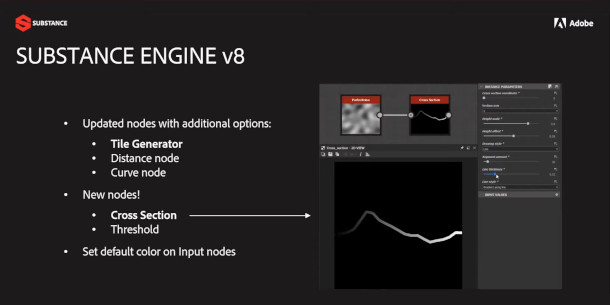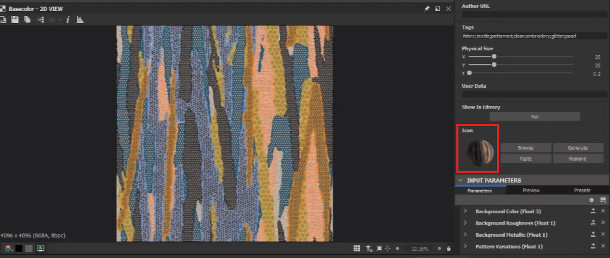Adobe ships Substance Designer 2020.2
Originally posted on 31 July 2020. Scroll down for news of the final release.
Adobe has released Substance Designer 2020.2, the next update to its material-authoring software.
The release, which is due to ship in September, updates the core architecture to Substance Engine 8, adding a versatile new Cross Section node and updating existing nodes like the Tile Generator.
Other changes include a new automatic thumbnail generation system for materials, and performance improvements that cut the time taken to update the 2D and 3D views by up to 60%.
The new features were announced yesterday during a livestream on Adobe’s 3D and augmented reality tools, the recording of which is embedded above. The Substance Designer section starts at 00:39:00.
A note on version numbers
In the slides shown during the livestream, the release is described as ‘Substance Designer 6.2’, but since Substance Designer 6.x shipped in 2017, we assume that’s a typo.
The current release is version 10.1 or 2020.1, which would make this Substance Designer 10.2 or 2020.2.

Substance Engine 8 brings new Cross Section node and updates to the Tile Generator
Regardless of which version number it proves to be, the release will update Substance Designer to Substance Engine 8, a new version of the core architecture.
Changes include a new Cross Section node (shown above), which literally takes a cross-section through procedural noise to generate an output that looks rather like a line graph.
Adobe described it as a versatile base from which to generate a range of custom effects, ranging from particle systems to animated textures.
Substance Engine 8 also brings updates to existing nodes, including the Tile Generator, which gets new Keep Ratio and Absolute modes to preserve the aspect ratio or dimensions of the tiles it generates.
A third new mode, Pixel, generates one-pixel tiles, which can be used as inputs for Voronoi noise.
Workflow improvements include the option to set default colours on Input nodes.
The change means that nodes set to accept normal inputs can be set to a colour that makes sense as a normal map, rather than defaulting to black or transparency.

New features: new thumbnail generation system and input exposition dialog
Other new features in Substance Designer 2020.2 include a new thumbnail generation system, which generates preview images for custom materials automatically, as shown in the screenshot above.
The thumbnails are rendered in a standard format, using the software’s PBR Render node.
The update will also add a new input exposition dialog: a single dialog box for exposing inputs in the node graph with more options that current workflows, including access to every group.
Adobe described it as “a big time-saver when exposing multiple parameters in a graph”.
Performance improvements: faster updates to the 2D and 3D previews
Adobe has also changed the way in which the node graph is calculated when loading a new material or when making edits to an existing material.
The software now calculates the output of the graph and updates the 2D and 3D previews before generating the new thumbnails for the nodes, rather than waiting for all the thumbnails before updating the previews.
The change cuts the time taken to iterate on a material by “sometimes 60%” with complex graphs.
Updated 13 October 2020: Substance Designer 2020.2 is now shipping. As well as the features covered above, the update adds new Manhattan and Chebyshev modes to the software’s Distance node.
In the examples in the release notes, they generate harder-edged patterns than the existing Euclidian mode.
The Gradient node gets a new Smooth mode, intended to generate smoother colour gradients than the existing Linear and Flat Tangent modes; and the Curve node can now output a greyscale image directly, without the need to connect a gradient texture.
The process of generating padding for texture tiles when baking textures has also been updated, which Adobe says leads to “an approximate 70% speed improvement on the overall baking time”.
In addition, the integrated version of the Iray renderer has been updated to support hardware-accelerated ray tracing on Nvidia’s new Ampere GPUs.
Pricing and availability
Substance Designer 2020.2 is available for Windows 8+, CentOS 7.0/Ubuntu 16.04 Linux and macOS 10.12+.
Subscriptions to all of Adobe’s Substance tools cost $19.90/month or $219/year for artists and studios earning under $100,000/year; and $99.90/month or $990/year for other users.
Perpetual Indie licences are only available via Steam, and cost $149.99.
Read an overview of the new features in Substance Designer 2020.2 on Adobe’s blog
Read a full list of new features in Substance Designer 2020.2 in the online release notes
